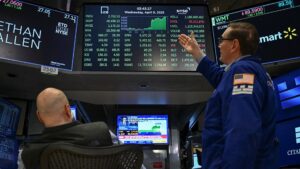Understanding the Shift: Global Investors Rethink U.S. Market Exposure
In the ever-evolving landscape of global finance, the focus is intensifying on how foreign investors are reassessing their stakes in U.S. markets. According to noted economist Rebecca Patterson, who once held the position of chief investment strategist at Bridgewater, a structural shift is underway. Let’s dive into the implications of this trend and what it means for you as an investor.
The Shift in Sentiment
At a recent gathering of economic leaders, including participants from the World Bank and International Monetary Fund, Patterson revealed that foreign investors are beginning to reduce their exposure to U.S. assets. This trend is driven not just by ongoing tariff discussions, but also by a prevailing uncertainty regarding the U.S.’s reliability as a partner in global commerce.
“There are a large number of foreign investors who are worried not only about tariffs but about America’s reliability as a partner,” Patterson shared in her recent CNBC interview.
This concern reflects a broader apprehension about how capital markets may be used as tools for achieving national economic objectives. In this context, investors are increasingly questioning whether maintaining significant U.S. holdings is prudent.
Understanding the Numbers
As of last June, foreign investors held over $31 trillion in U.S. assets, an increase of $4.4 trillion from the previous year. Much of this growth coincided with significant highs in U.S. markets, propelled by sectors like megacap tech and burgeoning trends in artificial intelligence.
However, Patterson’s insights raise crucial red flags. "They are looking at this huge allocation to the U.S. and asking, ‘Should we trim off the tops?’" This cautious approach is not without merit; even a modest reduction could have substantial ramifications for U.S. markets.
The Trillion-Dollar Question
Imagine being the chief investment officer of a major overseas pension fund. A slight strategy shift—say, reducing U.S. exposure by just 2%—would amount to a $1.2 trillion sell-off, approximately 2.3% of the S&P 500’s total market cap. While the execution of such changes is often slow and bureaucratic, the implications for the market can be profound.
"This will not happen overnight," Patterson notes. "However, it reflects a slow bleed of support from the U.S. markets."
As funds reassess their allocations, they may start reallocating towards home markets or exploring opportunities in alternative assets, including commodities like gold.
Comparative Performance
As of now, U.S. stocks have underperformed compared to global equities, with the S&P 500 down 4.7% year-to-date. In contrast, European markets have rallied, as evidenced by the STOXX 600, which has gained 5.7%, while Asia Pacific’s MSCI AC Index rose by 2.4%.
This divergence in performance signals a fundamental shift in capital flows that could reshape investment strategies for years to come.
What Investors Should Consider
Given these trends, it’s crucial for investors to stay informed and adaptable. Here are a few actionable insights:
-
Diversify Geographically: Don’t put all your eggs in one basket. Explore international markets that may offer better returns.
-
Hedge Against Volatility: Consider using gold and other alternative assets as a hedge against unpredictable market conditions.
-
Stay Updated: Regularly evaluate the geopolitical landscape and its potential impacts on your investment portfolio.
- Long-Term Perspective: Market fluctuations can often lead to short-term noise; focus on long-term growth opportunities.
In conclusion, understanding the shifting dynamics of global investment is essential for navigating the financial markets of the future. At Extreme Investor Network, we encourage our readers to stay vigilant and informed as these changes unfold. Your financial well-being depends on it.

